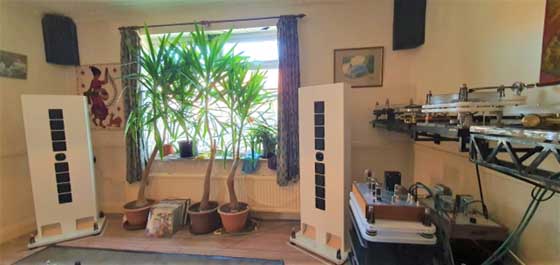New Etude High Sensitivity Bipole (EHSB)
Horn-like sensitivity and BMR impulse response, timbral accuracy and coherence are for the first time combined, in a game-changing high sensitivity balanced mode radiator (BMR) based bipolar transmission line design that is able to reproduce music at realistic scale, timbre and dynamics from just a few watts of single ended triode power
Design Philosophy
The EHSB is a result of my ongoing collaboration with Danny Baty of Super Natural Audio (SNA) (https://www.facebook.com/SuperNaruralAudio/) who is producing a 2.3 W single ended valve amplifier and needs a compatible high sensitivity loudspeaker. One of the targets for the EHSB is to be part of a full SNA system and will be badged accordingly in this context.
I have been somewhat underwhelmed by the vast majority of high sensitivity solutions based on traditional full range drive units, often front and back horn loaded, and multi-driver horn loaded designs. To attain satisfying levels in-room the sensitivity of the design would need to be at least 100 dB/W. I have always been interested in exploring high sensitivity and bipolar loudspeaker designs – so Danny’s need was a trigger to get designing and making!
Balanced mode radiator (BMR) full range drive units are the basis of my existing loudspeaker designs – the Curvi-BMR mk2 and the Etude 5. With mid-80’s dB/W sensitivity, these are simply not sensitive enough for SET lovers.
The only way to boost sensitivity whilst retaining the BMR approach is to use paralleled series arrays of drivers. Four parallel arms of four BMR drive units in series will give a theoretical overall sensitivity of 105 dB/W*, given an individual unit sensitivity of 87 dB/W. A sixteen 85 mm BMR solution was the target, but so was a domestically acceptable cabinet height, combined with real-live instrument sound propagation. The solution I arrived at is a symmetrical bipolar design just 150 mm deep, with inverse tapered transmission line loading. The four arms of four BMR drive units are driven directly giving a DC impedance of 4 ohms. It is possible to roll-off the treble output of rear drivers should room positioning demand it. As with the Etude 5, the natural high frequency roll-off due to the combined voice coil inductance is countered using a tweeter coming in at about 7 kHz, the tweeter for the EHSB had to be a high sensitivity design so a quality compression tweeter was selected. The high pass filter network includes quad-parallel thick film resistors for preservation of timbre and dynamics, a Jantzen Superior Z-Cap polypropylene capacitor and an air-core bonded wire Jantzen inductor. The tweeter sharpens the stereo image and increases the effortlessness of the dynamics. Bass extends to 22 Hz (-5 dB ref 200 Hz) in room (63 m3). The speaker has power handling in excess of 200 W and will work well with higher power amplifiers though deficiencies in design are laid bare due to the highly revealing nature of the EHSB.
The EHSB has been evaluated with a range of amplifiers from a Purifi Eigentakt based class D design to a linear class AB type and a couple of single figure wattage single ended triode designs including Danny Baty’s Super Natural Audio 2.3 SE. I could not believe the improvement in dynamics, transparency and general realism when changing from the high-power class D and linear designs to the low power SET amplifiers with much simpler circuits and no phase splitting components.
The direct sale price per pair (piano lacquered moisture resistant higher density MDF cabinet and considering current drive unit prices) will be from £6500 / pair. The Clipaudio Mute Point isolation base is also an option (£1200/pair supplement) which adds greater poise and focus.
*The actual measured sensitivity figure will be dependent on many factors for a bipolar loudspeaker
Basic specifications
- Dimensions (excluding base) W x H x D (mm): 500 x 1550 x 150
- Dimensions (including standard 36 mm MDF base, but excluding spikes) W x H x D (mm): 600 x 1586 x 450
- Mass (kg) 35 (Approx)
- Theoretical total sensitivity (dB (1 W at 1 m)): 105 (summed output from front and rear) – This figure will depend on the proportion of rear contribution reflecting off room boundaries.
- Power handling in excess of 200 W / speaker (each BMR drive unit can handle 20 W (IEC268-5))
- Frequency response of stereo pair in a 63 m3 room at 3.4 m: 20 Hz to 20 kHz (-7 dB points ref 1 kHz) – a natural balance response with downward slope from 700 Hz, is the default setting. Tweeter level can be varied by changing the resistor and inductor to suit different rooms and tastes.
- Minimum impedance 4 ohms

